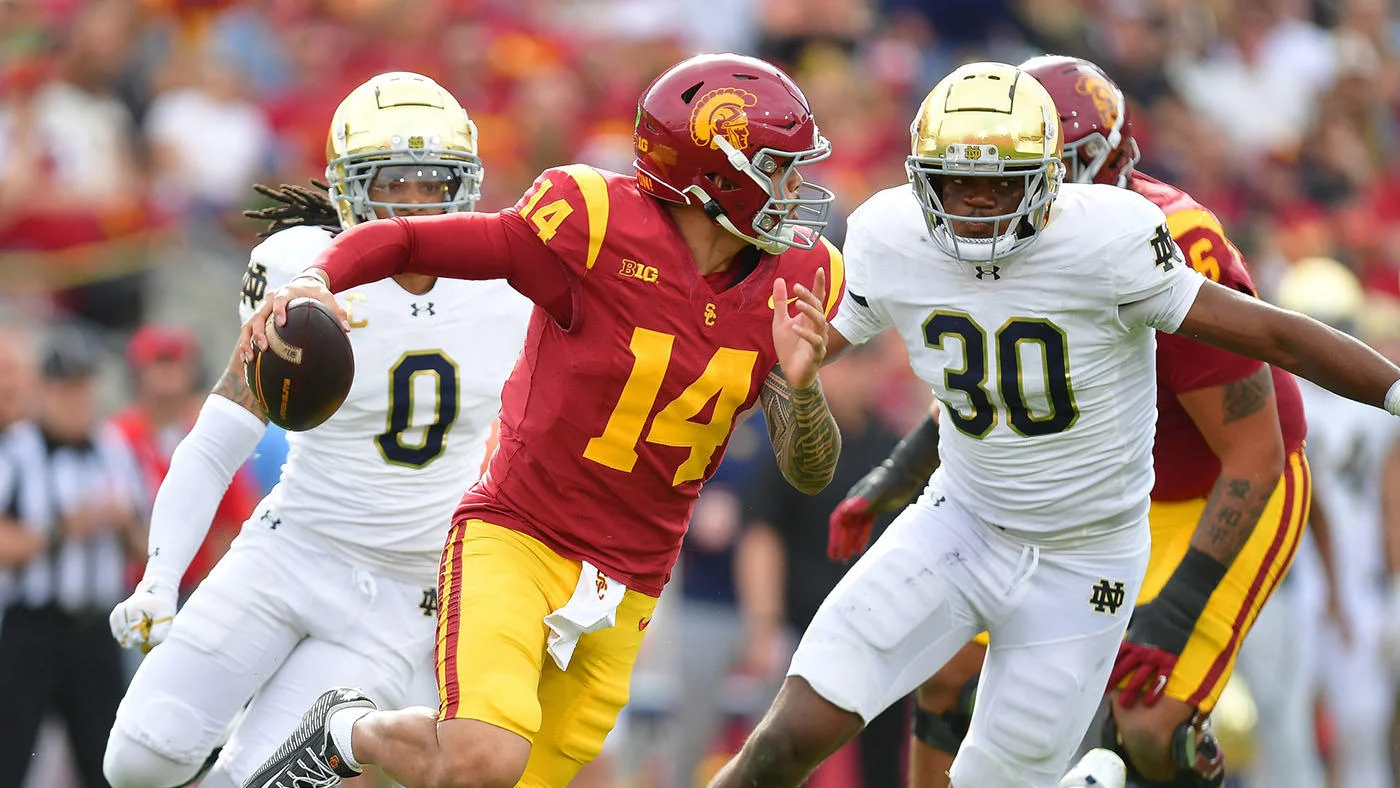When college football legends clash, only a few matchups command the respect and tradition of USC versus Notre Dame. This isn’t merely another game on the schedule; instead, it’s a century-spanning saga that transcends regional boundaries and embodies everything magnificent about American collegiate athletics.
The Trojans—Fighting Irish rivalry represents more than touchdowns and trophies. It connects West Coast style with Midwest values, creating unforgettable moments that shape players’ careers while highlighting two of America’s top academic and athletic programs competing at their best.

The Legacy of USC vs. Notre Dame: How a Coast-to-Coast Rivalry Shaped College Football History
The USC-Notre Dame rivalry emerged from an unlikely conversation in 1926 between coaches’ wives during a Nebraska game. Mrs. Wilson convinced Mrs. Rockne that biennial trips to sunny Southern California would beat cold and hostile Nebraska venues, a discussion that forever changed college football’s landscape.
The wives’ persuasive conversation convinced Notre Dame coach Knute Rockne to establish the annual home and home series with USC, which was officially announced on Dec. 4, 1926. This worked because both schools had complementary needs.
Notre Dame’s Big Ten exclusion left them seeking quality opponents, while USC wanted national recognition. Rockne’s earlier recommendation of Howard Jones as USC’s coach had already set the stage perfectly.
The first meeting in 1926 ended with Notre Dame winning 13-12, prompting Rockne to declare it the greatest game he had ever seen. This inaugural contest set the tone for what would become college football’s premier intersectional rivalry, featuring unprecedented drama and national significance.
From 1928 to 1932, both programs demonstrated their emerging dominance by combining for five consecutive national championships. USC claimed titles in 1928, 1931, and 1932, while Notre Dame captured championships in 1929 and 1930, establishing both as legitimate national powerhouses.
This era of excellence set the stage for decades of memorable battles between the programs, eventually inspiring the creation of a lasting symbol.
The Jeweled Shillelagh, introduced in 1952 by the Notre Dame Alumni Club of Los Angeles, serves as this rivalry’s symbolic centerpiece. Made from Irish oak or blackthorn saplings, the trophy features ruby-adorned Trojan heads for USC victories and emerald-studded shamrocks representing Notre Dame wins.
Perhaps no single game better captures the rivalry’s dramatic potential than what happened in 1974 in Los Angeles. The “Comeback” game epitomizes this rivalry’s capacity for stunning drama. Notre Dame led 24-0 before USC exploded for 55 points in just 17 minutes, winning 55-24.
After USC’s remarkable comeback, Notre Dame’s president, Father Theodore Hesburgh, told USC coach John McKay, “That wasn’t very nice.” McKay known for his wit replied “That’s what you get for hiring a Presbyterian!” referring to Notre Dame coach Ara Parseghian’s faith, a moment that captured the rivalry’s competitive spirit.
USC’s golden era from 1967-1982 saw the Trojans post a 12-2-2 record against Notre Dame. It featured legendary performances like O.J. Simpson’s 160-yard rushing display in USC’s 1967 victory in South Bend. The 1968 contest ended in a memorable 21-21 tie despite Simpson’s Heisman Trophy season.
Notre Dame dominated from 1983 to 1995 with a remarkable 11-0-1 record against USC, including eight consecutive victories under Lou Holtz. This streak represented one of the most dominant stretches by either team in the rivalry’s storied history, showcasing the Irish’s sustained excellence.
The 1988 matchup remains legendary as the only time both teams entered ranked first and second nationally. Despite suspending stars Ricky Watters and Tony Brooks for disciplinary reasons, Notre Dame dominated USC 27-10 behind defensive stars Frank Stams and Stan Smagala en route to the national championship.
KEEP READING: USC Booster’s Haw-Dropping Threat Over Notre Dame Series Sparks Major Buzz
For nearly a century, this rivalry has endured coaching changes, conference realignments, and college football’s constant evolution. In 2024, the teams produced the highest-scoring contest in rivalry history, with Notre Dame winning 49-35. The game featured two consecutive fourth-quarter interception returns for touchdowns of 99 and 100 yards, respectively.
USC’s move to the Big Ten Conference has created unprecedented scheduling challenges threatening this tradition. The Trojans now face massive travel demands to distant opponents like Purdue (2,093 miles) and Illinois (2,002 miles), while navigating uncertainty about future College Football Playoff formats and automatic qualifier spots.
Notre Dame athletic director Pete Bevacqua has been vocal about continuing the series, stating, “I think Southern Cal and Notre Dame should play every year for as long as college football is played, and SC knows that’s how we feel.” USC has proposed moving the game earlier in the season, though Notre Dame prefers. USCris aditional late-season timing.
However, this treasured rivalry now faces its greatest existential threat. The current contract expires after 2025, with USC reportedly reluctant to commit long term due to Big Ten scheduling demands and College Football Playoff uncertainty, potentially ending college football’s most cherished intersectional tradition.
The stakes extend beyond just scheduling convenience. This rivalry has showcased college football’s greatest talents across generations, with both programs combining for 15 Heisman Trophy winners and producing numerous NFL stars who give their all in this intense annual battle.
From legendary coaches to future professional standouts, losing this series would eliminate a showcase for elite talent competing at college football’s highest level.
College Sports Network has you covered with the latest news, analysis, insights, and trending stories in football, men’s basketball, women’s basketball, and baseball!

